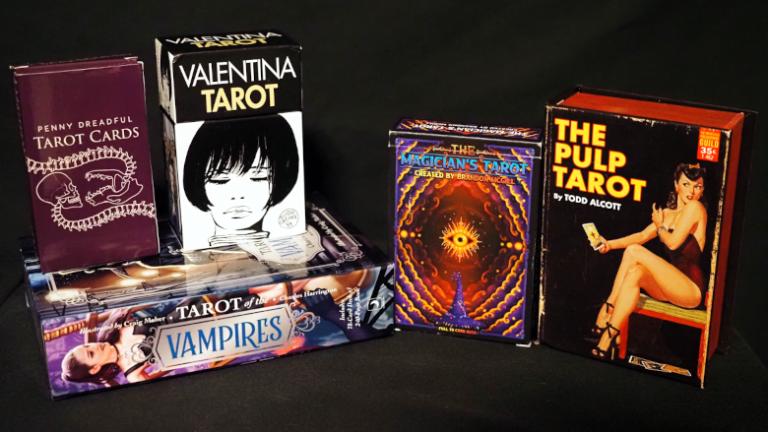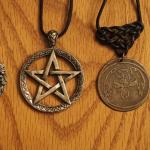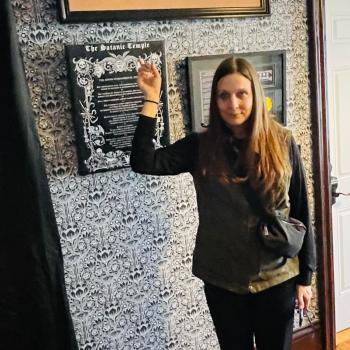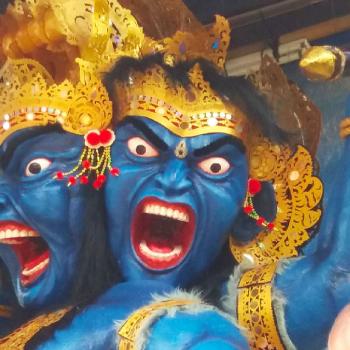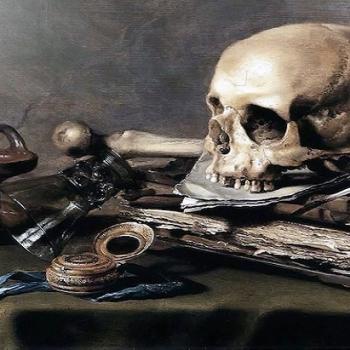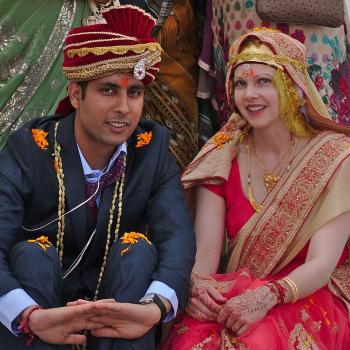One of the first things I bought when I started my magical journey was a deck of Tarot cards. The friend who introduced me to Wicca recommended the Robin Wood Tarot – it was a good recommendation. Robin Wood follows the structure and themes of the more popular Waite-Smith deck very closely, but it replaces all the Christian and Jewish imagery with modern Pagan images and concepts. It worked very well for me.
It worked so well that Robin Wood was my only deck for 13 years. Then I signed up for Dolores Nabors’ Tarot class, and Dolores taught from Waite-Smith. So I bought that deck and got familiar with it. Again, that was enough – I had only those two decks for another 11 years.
In 2017 Kristoffer Hughes created the Celtic Tarot. It looked like an excellent deck, so I bought it, and found that it spoke to me very clearly. It’s been my most frequently used deck ever since, including in my annual New Year’s divinations. After that I had three decks – why would I need another?
Because Tarot decks can be addictive, that’s why.
Shortly after getting Celtic Tarot, a friend was selling some old decks. I bought Aleister Crowley’s Thoth deck from her because I love the artwork. I struggle to read with Thoth, but there are times when it’s the right deck for the right question. And I do love the Art Deco imagery.
After that, the floodgates opened. The only deck I bought specifically for divination was Sola Busca, the oldest deck for which we have the full set of 78 cards. It’s very hard to read with, although for some questions, it’s the most appropriate deck. Other than that, I bought decks because I liked the artwork, or in one case, because I wanted a connection to a story I found intriguing.
Occasionally I see debates about which deck is the “most authentic” or even “the best.” Those are silly debates. Older and more popular decks – such as Waite-Smith or Tarot de Marseille – have residual energies built up in them and can be quite powerful. So can newer decks like Robin Wood or Celtic Tarot. But at the end of the day, the best deck is the one you can get good, reliable answers with. Beyond that, reading with a new and different deck can force you to focus on the images on the cards, rather than trying to recall what the “proper” meaning of that card is supposed to be.
And sometimes, new and different decks are just fun. We can use more fun.
Here are five relatively new Tarot decks I find interesting.
Valentina Tarot
- Artwork by Guido Crepax, published by Lo Scarabeo, republished by Llewellyn. $26.95.
- Standard Tarot size, with a nicer-than-usual little white book.
Italian artist Guido Crepax (1933 – 2003) drew his Valentina comics series for over 30 years. The title character Valentina was a fashion photographer who found herself in all kinds of unusual situations, some realistic and some more dreamlike. I’ve been fascinated with Crepax’s artwork for a very long time, and when I saw this deck was coming out in 2021 I had to have it.
I can’t figure out who curated this deck, which includes artwork from some of Crepax’s other series. Like all the decks in this review, it’s presented in the Waite-Smith format. Some of the imagery matches Waite-Smith very closely – much of it does not.
While the cards are the typical 4¾” x 2¾”, they’re considerably thicker and stiffer than usual, making them hard to shuffle.
This isn’t a deck I would recommend for deep spiritual questions. I’ve had some success using it for questions concerning how the querent presents themselves to the wider world – appropriate for artwork inspired by the fashion industry.
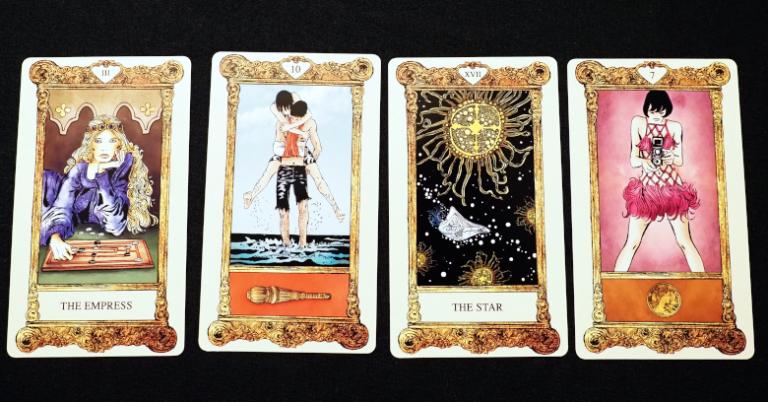
The Magician’s Tarot
- Created by Brandon McGill. Self-published. $59.99.
- Oversized cards (5” x 3½”), with a very brief guide to interpretation.
Unlike most decks, the images in The Magician’s Tarot are not drawings but photographic manipulations. The people in the deck represent virtually every gender, orientation, skin color, and body type imaginable. If you’re looking for diversity in Tarot imagery, this is your deck.
This was a Kickstarter project. I backed it because I’m friends with one of the models.
McGill clearly tried to make his imagery fit into the Waite-Smith format – some cards accomplish that better than others. That doesn’t mean the others are “bad” – it does mean you have to read the pictures in front of you and not try to force them into a “standard” meaning that doesn’t fit.
Although these cards are oversized, they’re flexible and thus easier to shuffle than those in the smaller but stiffer Valentina Tarot.
I struggle to read with this deck – it just feels too different for me. But the artwork is beautiful, and there’s definitely enough depth in the imagery to facilitate good readings – if this style of Tarot appeals to you.
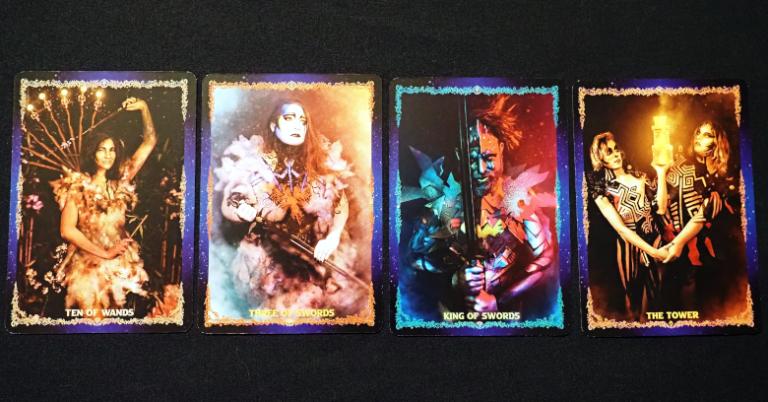
Tarot of the Vampires
- Created by Charles Harrington, illustrated by Craig Maher. Published by Llewellyn. $31.99.
- Standard Tarot size, with a slick color Codex of the Vampires book explaining the cards, presented in an oversized box.
This is the newest of my decks. Someone was complaining about it making Pagans not be taken seriously (Really? This is what you want to complain about?). I looked it up, liked the artwork, and bought it.
Tarot of the Vampires draws from classic vampire lore, but places it in our time: think urban fantasy, not Dracula or Carmilla. It tries to stick to the Waite-Smith themes and it’s close on most cards, but they feel very different. I haven’t tried reading with it yet, but I suspect it will do well for certain questions and certain querents, but not for most. Mainly I like the artwork.
Interestingly, while there’s plenty of blood, this deck is mostly PG-13.
The cards are standard size, standard thickness, and reasonably flexible – they’re easy to shuffle.
Note: Llewellyn also publishes The Tarot of Vampyres by Ian Daniels. I don’t have that deck, but from what I can see on the internet I like this one slightly better. In any case, if you decide to buy a vampire Tarot deck, make sure you’re ordering what you think you’re ordering.
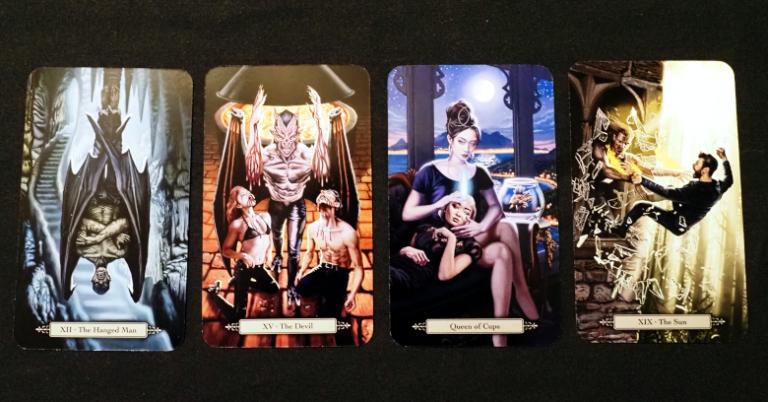
The Pulp Tarot
- Created by Todd Alcott. Published by The Unemployed Philosophers Guild. $24.95.
- Standard Tarot size, with a fairly typical little white book, presented in a box made to look like a pulp novel of the mid-20th century.
Artist Todd Alcott is making a career of “cultural mashups.” He has an Etsy shop full of 80s and 90s album covers reimagined with 50s and 60s artwork. As someone Of A Certain Age, this hits me on both ends. I remember magazines and book covers like this as a kid, and Talking Heads, David Bowie, and Leonard Cohen are some of my favorite musical artists from my young adult years.
And then there’s The Pulp Tarot. I think Alcott tried harder than any of the other creators here to not just make his cards fit into the Waite-Smith system, but to embody the Waite-Smith themes are closely as possible. I haven’t read with it much, but when I have it’s been pretty clear – though I suspect it would be harder for someone who isn’t familiar with pulp novels and film noir.
Then again, I imagine most people who buy this deck will be very familiar with pulp novels and film noir. If you like it, you can probably read with it.
This was another Kickstarter project. I discovered it after it was finished – I got mine from Amazon.
The cards are standard thickness and are OK to shuffle. I suspect they’ll get more flexible the more they’re used.
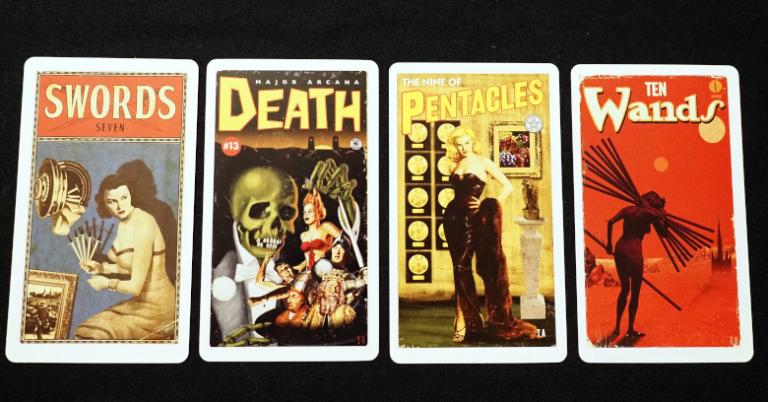
Penny Dreadful Tarot
- Created by Anais Chareyre. Published by Showtime. Original price $14.95, now only available second-hand.
- Standard Tarot size, with a card with 1-line meanings in place of a little white book.
I love Penny Dreadful (the original series that ran from 2014-2016, not the 1-season debacle from 2020). I’ve mentioned it here a few times, especially with this post titled I’m Better Than Vanessa Ives – I Hope To Be As Good As Vanessa Ives. Vanessa (played by Eva Green) occasionally reads Tarot, and the show created a deck just for her. When I found out it was available I had to have it.
The artwork in this deck consists of white line drawings on a purple background. While it follows the Waite-Smith format, the imagery bears little resemblance to – or correspondence with – the art of Pamela Colman Smith.
You can perform cartomancy with pretty much any deck of cards. Camelia Elias wrote a “Read Like The Devil” book for divination with playing cards. You can read with the Penny Dreadful Tarot, and I’ve done it.
But it’s very difficult. If you’re not familiar with the show, it will be even harder.
Additionally, this is the lowest quality Tarot deck I’ve ever come across. The cards are thin and easy to shuffle, but they’re so thin they’re also easy to crease and mark. The trim is inconsistent, meaning some of the cards are slightly larger than others.
If you’re a Penny Dreadful fanatic you probably want this deck. I can’t recommend it for anyone else.
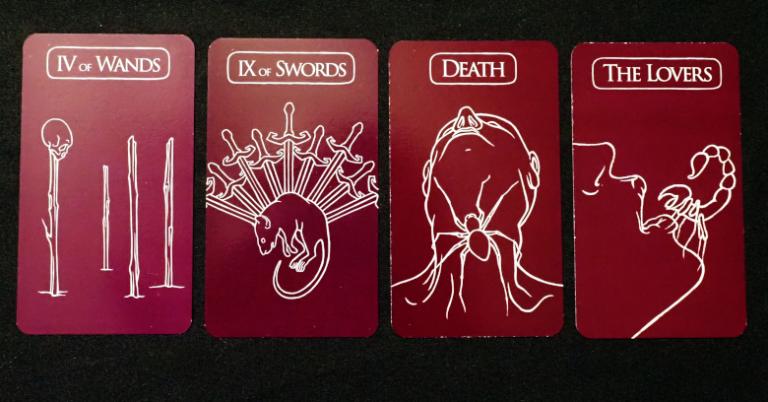
Just read the cards
Perhaps the most important thing I’ve learned from Camelia Elias is “just read the damn cards.” Forget about the book meanings: what do the cards say, in the context of the question presented? I had to learn the consensus meanings first. That gave me the confidence to look at the cards and let them speak to me.
That’s the best way to approach non-traditional Tarot decks like these. Don’t worry if the images don’t line up with what the Three of Swords or the King of Pentacles is “supposed” to mean. Just look at what you see, what catches your attention, what seems relevant to the question at hand.
Or you could just enjoy contemplating some beautiful and fascinating artwork.
For those who care about such things, I bought all of these decks myself. I get nothing from the links – they’re here for your convenience. I wrote this post because I find non-traditional Tarot decks fascinating and I wanted to write about these five.
Want to learn to read Tarot? I have a course for that! The first run of Tarot For Divination is complete, but the course is on-line and you can take it at any time.


